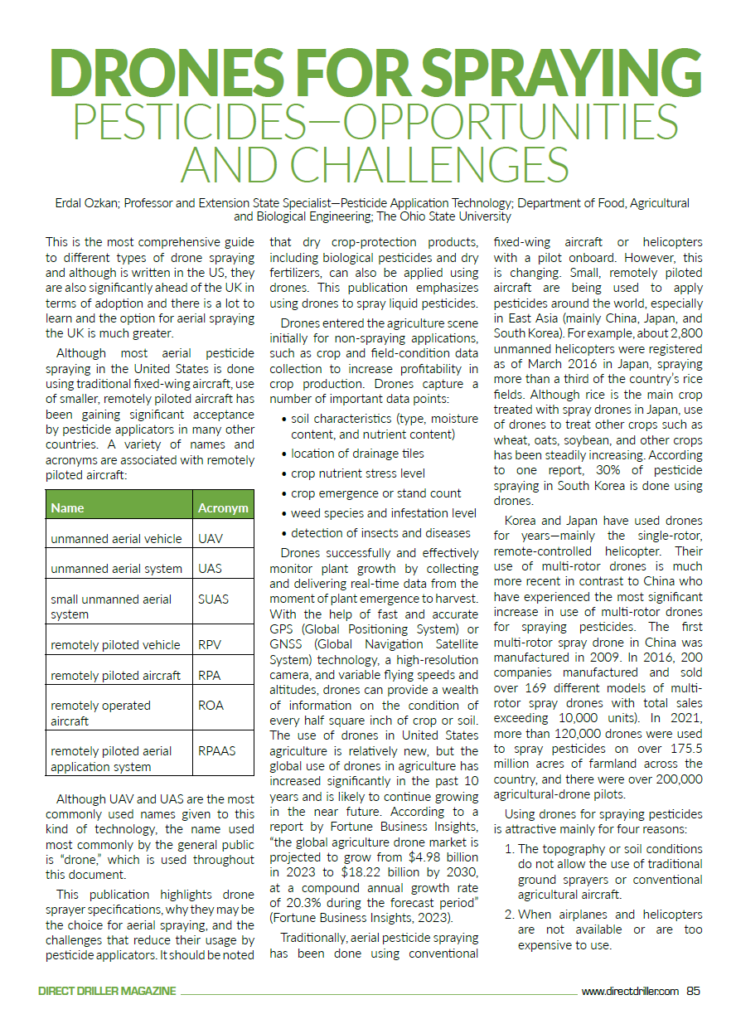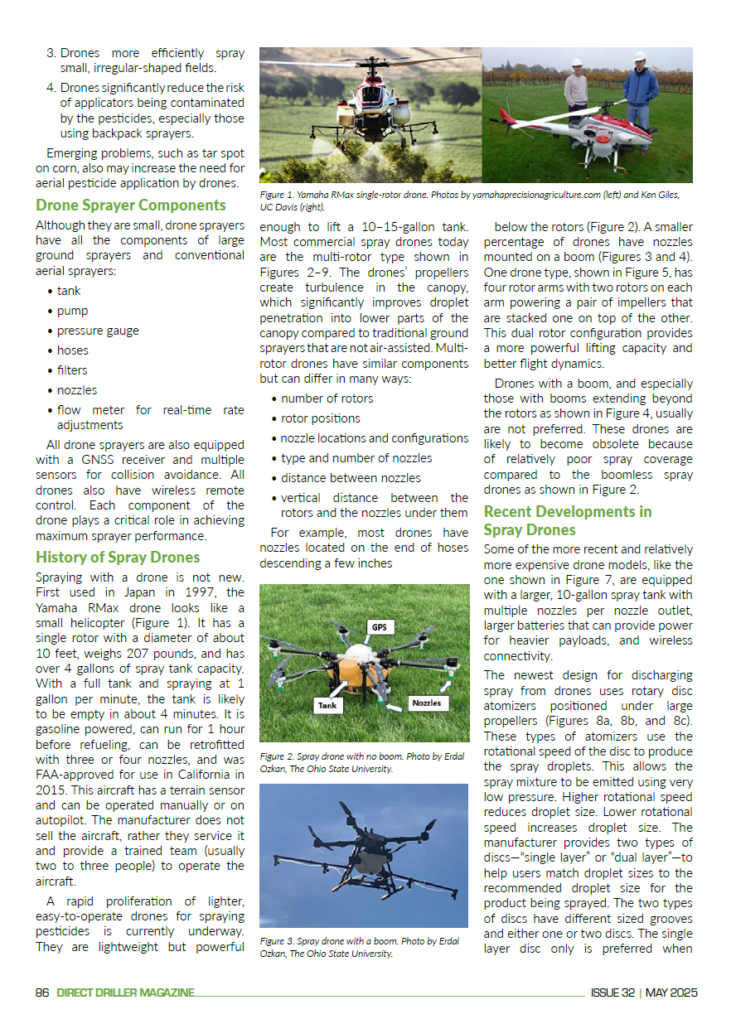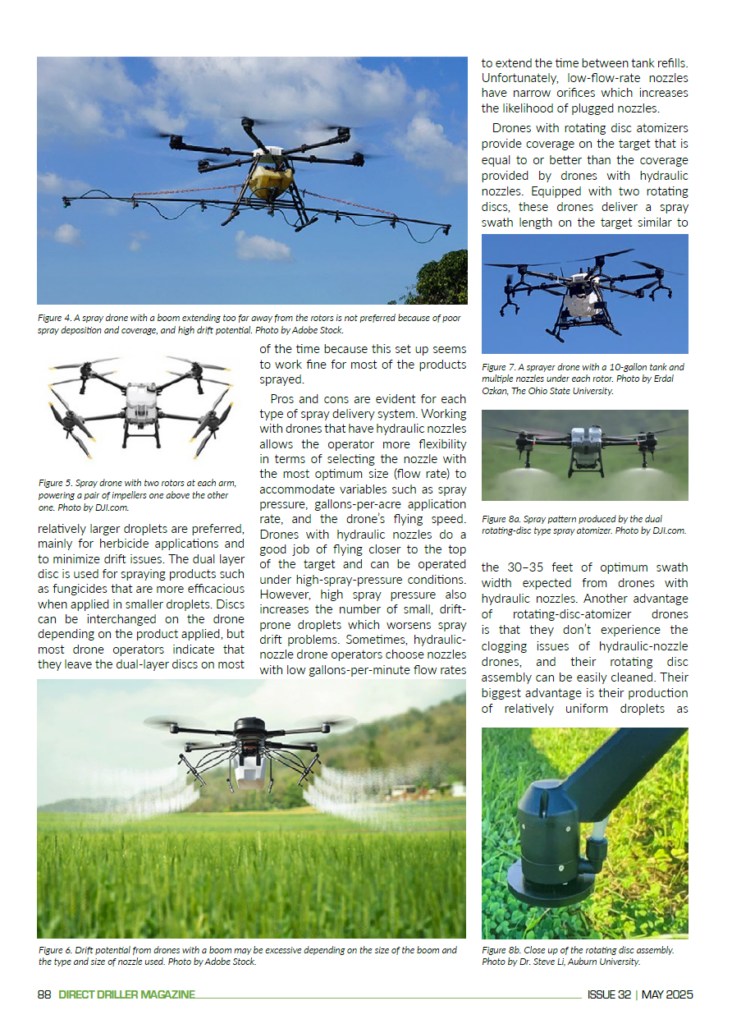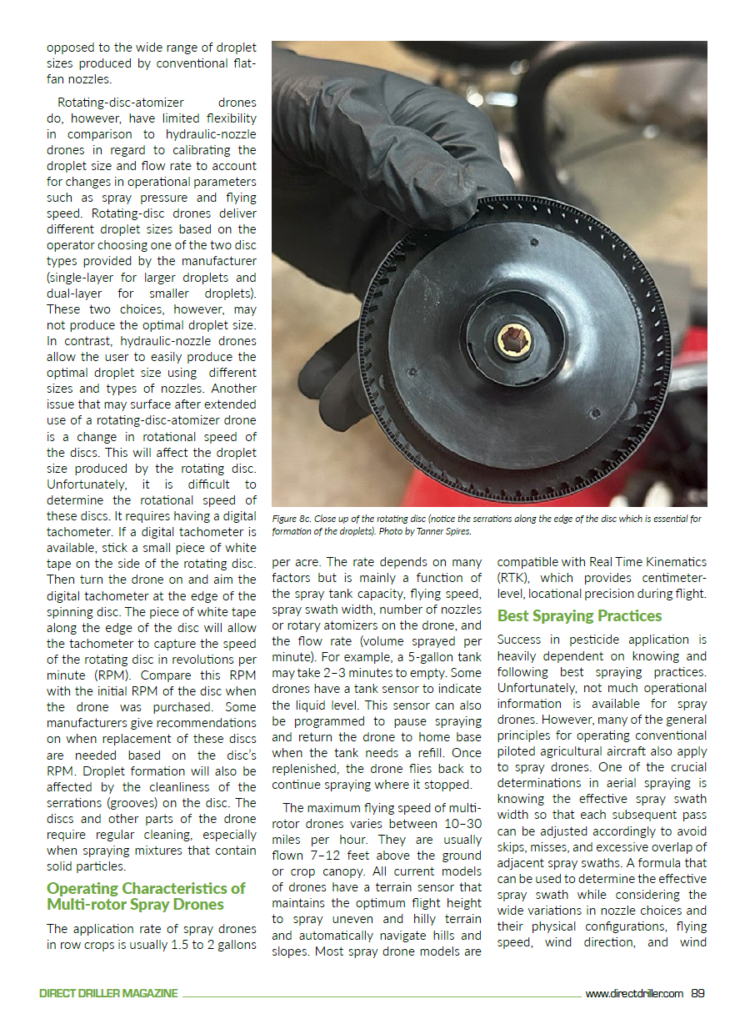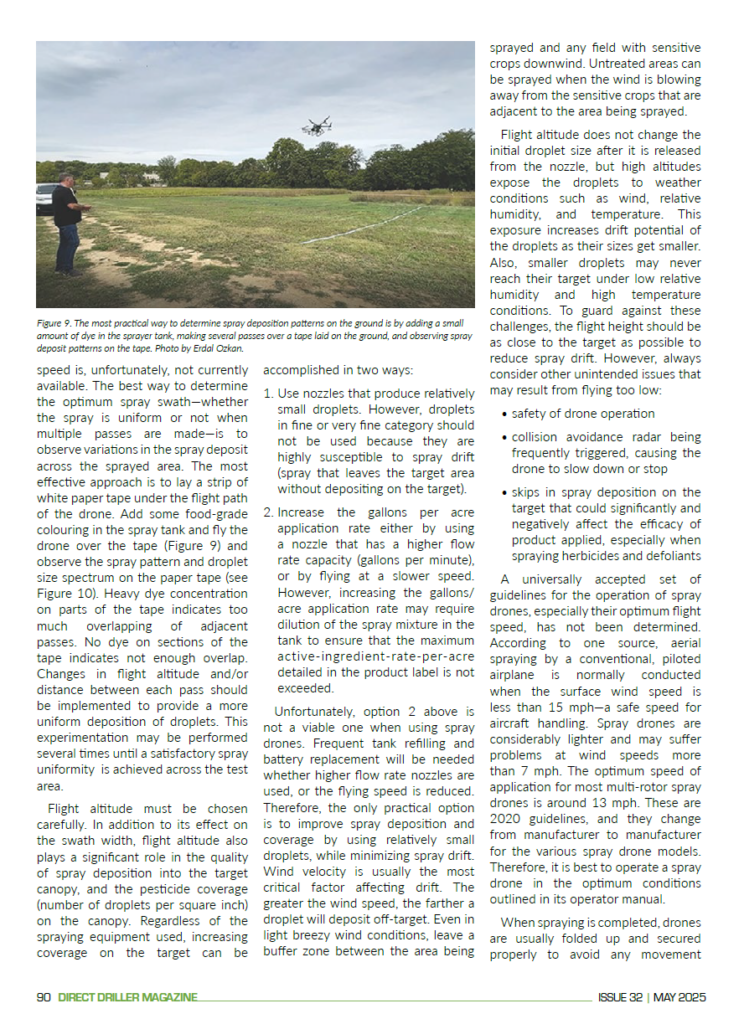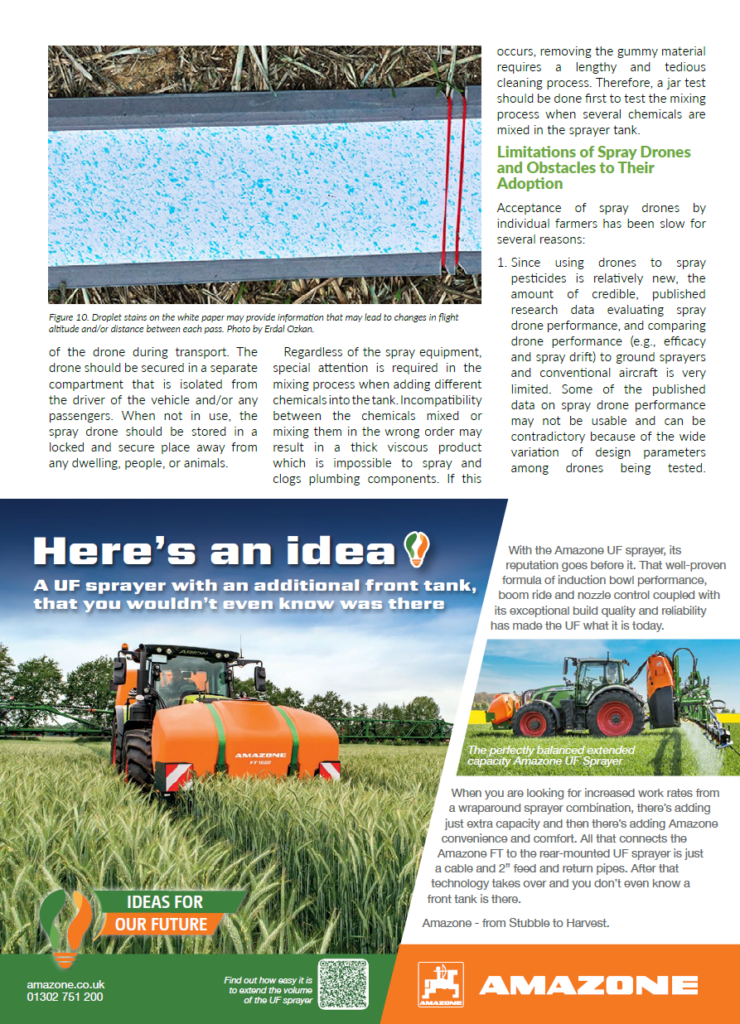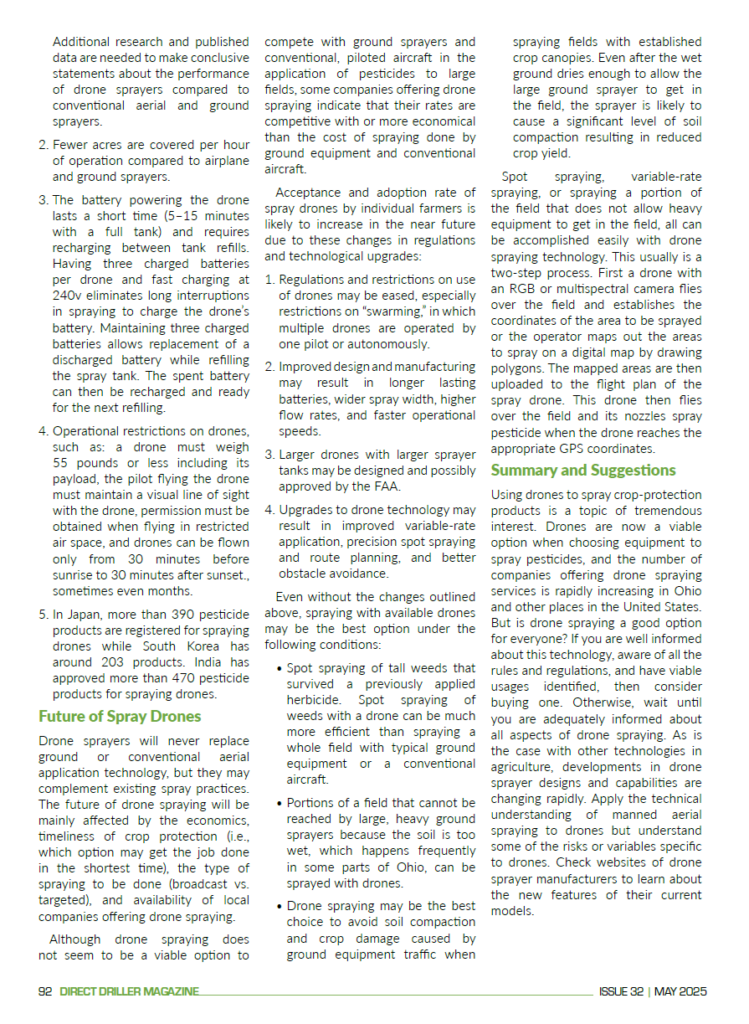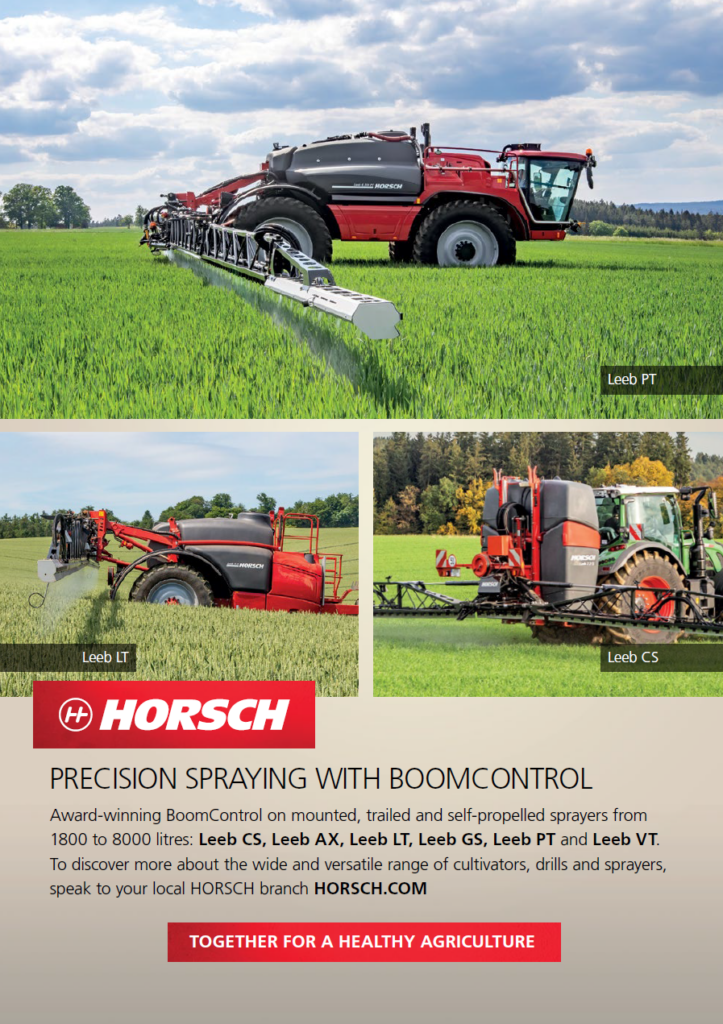Erdal Ozkan; Professor and Extension State Specialist—Pesticide Application Technology; Department of Food, Agricultural and Biological Engineering; The Ohio State University
Direct Driller Note – this is the most comprehensive guide to different types of drone spraying and although is written in the US, they are also significantly ahead of the UK in terms of adoption and there is a lot to learn and the option for aerial spraying the UK is much greater.
Although most aerial pesticide spraying in the United States is done using traditional fixed-wing aircraft, use of smaller, remotely piloted aircraft has been gaining significant acceptance by pesticide applicators in many other countries. A variety of names and acronyms are associated with remotely piloted aircraft:
| Name | Acronym |
| unmanned aerial vehicle | UAV |
| unmanned aerial system | UAS |
| small unmanned aerial system | SUAS |
| remotely piloted vehicle | RPV |
| remotely piloted aircraft | RPA |
| remotely operated aircraft | ROA |
| remotely piloted aerial application system | RPAAS |
Although UAV and UAS are the most commonly used names given to this kind of technology, the name used most commonly by the general public is “drone,” which is used throughout this document.
This publication highlights drone sprayer specifications, why they may be the choice for aerial spraying, and the challenges that reduce their usage by pesticide applicators. It should be noted that dry crop-protection products, including biological pesticides and dry fertilizers, can also be applied using drones. This publication emphasizes using drones to spray liquid pesticides.
Drones entered the agriculture scene initially for non-spraying applications, such as crop and field-condition data collection to increase profitability in crop production. Drones capture a number of important data points:
- soil characteristics (type, moisture content, and nutrient content)
- location of drainage tiles
- crop nutrient stress level
- crop emergence or stand count
- weed species and infestation level
- detection of insects and diseases
Drones successfully and effectively monitor plant growth by collecting and delivering real-time data from the moment of plant emergence to harvest. With the help of fast and accurate GPS (Global Positioning System) or GNSS (Global Navigation Satellite System) technology, a high-resolution camera, and variable flying speeds and altitudes, drones can provide a wealth of information on the condition of every half square inch of crop or soil. The use of drones in United States agriculture is relatively new, but the global use of drones in agriculture has increased significantly in the past 10 years and is likely to continue growing in the near future. According to a report by Fortune Business Insights, “the global agriculture drone market is projected to grow from $4.98 billion in 2023 to $18.22 billion by 2030, at a compound annual growth rate of 20.3% during the forecast period” (Fortune Business Insights, 2023).
Traditionally, aerial pesticide spraying has been done using conventional fixed-wing aircraft or helicopters with a pilot onboard. However, this is changing. Small, remotely piloted aircraft are being used to apply pesticides around the world, especially in East Asia (mainly China, Japan, and South Korea). For example, about 2,800 unmanned helicopters were registered as of March 2016 in Japan, spraying more than a third of the country’s rice fields. Although rice is the main crop treated with spray drones in Japan, use of drones to treat other crops such as wheat, oats, soybean, and other crops has been steadily increasing. According to one report, 30% of pesticide spraying in South Korea is done using drones.
Korea and Japan have used drones for years—mainly the single-rotor, remote-controlled helicopter. Their use of multi-rotor drones is much more recent in contrast to China who have experienced the most significant increase in use of multi-rotor drones for spraying pesticides. The first multi-rotor spray drone in China was manufactured in 2009. In 2016, 200 companies manufactured and sold over 169 different models of multi-rotor spray drones with total sales exceeding 10,000 units). In 2021, more than 120,000 drones were used to spray pesticides on over 175.5 million acres of farmland across the country, and there were over 200,000 agricultural-drone pilots.
Using drones for spraying pesticides is attractive mainly for four reasons:
- The topography or soil conditions do not allow the use of traditional ground sprayers or conventional agricultural aircraft.
- When airplanes and helicopters are not available or are too expensive to use.
- Drones more efficiently spray small, irregular-shaped fields.
- Drones significantly reduce the risk of applicators being contaminated by the pesticides, especially those using backpack sprayers.
Emerging problems, such as tar spot on corn, also may increase the need for aerial pesticide application by drones.
Drone Sprayer Components
Although they are small, drone sprayers have all the components of large ground sprayers and conventional aerial sprayers:
- tank
- pump
- pressure gauge
- hoses
- filters
- nozzles
- flow meter for real-time rate adjustments
All drone sprayers are also equipped with a GNSS receiver and multiple sensors for collision avoidance. All drones also have wireless remote control. Each component of the drone plays a critical role in achieving maximum sprayer performance.
History of Spray Drones

Figure 1. Yamaha RMax single-rotor drone. Photos by yamahaprecisionagriculture.com (left) and Ken Giles, UC Davis (right).
Spraying with a drone is not new. First used in Japan in 1997, the Yamaha RMax drone looks like a small helicopter (Figure 1). It has a single rotor with a diameter of about 10 feet, weighs 207 pounds, and has over 4 gallons of spray tank capacity. With a full tank and spraying at 1 gallon per minute, the tank is likely to be empty in about 4 minutes. It is gasoline powered, can run for 1 hour before refueling, can be retrofitted with three or four nozzles, and was FAA-approved for use in California in 2015. This aircraft has a terrain sensor and can be operated manually or on autopilot. The manufacturer does not sell the aircraft, rather they service it and provide a trained team (usually two to three people) to operate the aircraft.
A rapid proliferation of lighter, easy-to-operate drones for spraying pesticides is currently underway. They are lightweight but powerful enough to lift a 10–15-gallon tank. Most commercial spray drones today are the multi-rotor type shown in Figures 2–9. The drones’ propellers create turbulence in the canopy, which significantly improves droplet penetration into lower parts of the canopy compared to traditional ground sprayers that are not air-assisted. Multi-rotor drones have similar components but can differ in many ways:
- number of rotors
- rotor positions
- nozzle locations and configurations
- type and number of nozzles
- distance between nozzles
- vertical distance between the rotors and the nozzles under them
| Figure 2. Spray drone with no boom. Photo by Erdal Ozkan, The Ohio State University. | |




For example, most drones have nozzles located on the end of hoses descending a few inches
below the rotors (Figure 2). A smaller percentage of drones have nozzles mounted on a boom (Figures 3 and 4). One drone type, shown in Figure 5, has four rotor arms with two rotors on each arm powering a pair of impellers that are stacked one on top of the other. This dual rotor configuration provides a more powerful lifting capacity and better flight dynamics.
Drones with a boom, and especially those with booms extending beyond the rotors as shown in Figure 4, usually are not preferred. These drones are likely to become obsolete because of relatively poor spray coverage compared to the boomless spray drones as shown in Figure 2.
Recent Developments in Spray Drones

Figure 6. Drift potential from drones with a boom may be excessive depending on the size of the boom and the type and size of nozzle used. Photo by Adobe Stock.
Some of the more recent and relatively more expensive drone models, like the one shown in Figure 7, are equipped with a larger, 10-gallon spray tank with multiple nozzles per nozzle outlet, larger batteries that can provide power for heavier payloads, and wireless connectivity.
The newest design for discharging spray from drones uses rotary disc atomizers positioned under large propellers (Figures 8a, 8b, and 8c). These types of atomizers use the rotational speed of the disc to produce the spray droplets. This allows the spray mixture to be emitted using very low pressure. Higher rotational speed reduces droplet size. Lower rotational speed increases droplet size. The manufacturer provides two types of discs—“single layer” or “dual layer”—to help users match droplet sizes to the recommended droplet size for the product being sprayed. The two types of discs have different sized grooves and either one or two discs. The single layer disc only is preferred when relatively larger droplets are preferred, mainly for herbicide applications and to minimize drift issues. The dual layer disc is used for spraying products such as fungicides that are more efficacious when applied in smaller droplets. Discs can be interchanged on the drone depending on the product applied, but most drone operators indicate that they leave the dual-layer discs on most of the time because this set up seems to work fine for most of the products sprayed.

Figure 7. A sprayer drone with a 10-gallon tank and multiple nozzles under each rotor. Photo by Erdal Ozkan, The Ohio State University.
Pros and cons are evident for each type of spray delivery system. Working with drones that have hydraulic nozzles allows the operator more flexibility in terms of selecting the nozzle with the most optimum size (flow rate) to accommodate variables such as spray pressure, gallons-per-acre application rate, and the drone’s flying speed. Drones with hydraulic nozzles do a good job of flying closer to the top of the target and can be operated under high-spray-pressure conditions. However, high spray pressure also increases the number of small, drift-prone droplets which worsens spray drift problems. Sometimes, hydraulic-nozzle drone operators choose nozzles with low gallons-per-minute flow rates to extend the time between tank refills. Unfortunately, low-flow-rate nozzles have narrow orifices which increases the likelihood of plugged nozzles.

Figure 8a. Spray pattern produced by the dual rotating-disc type spray atomizer. Photo by DJI.com.
Drones with rotating disc atomizers provide coverage on the target that is equal to or better than the coverage provided by drones with hydraulic nozzles. Equipped with two rotating discs, these drones deliver a spray swath length on the target similar to the 30–35 feet of optimum swath width expected from drones with hydraulic nozzles. Another advantage of rotating-disc-atomizer drones is that they don’t experience the clogging issues of hydraulic-nozzle drones, and their rotating disc assembly can be easily cleaned. Their biggest advantage is their production of relatively uniform droplets as opposed to the wide range of droplet sizes produced by conventional flat-fan nozzles.

Figure 8b. Close up of the rotating disc assembly. Photo by Dr. Steve Li, Auburn University.
Rotating-disc-atomizer drones do, however, have limited flexibility in comparison to hydraulic-nozzle drones in regard to calibrating the droplet size and flow rate to account for changes in operational parameters such as spray pressure and flying speed. Rotating-disc drones deliver different droplet sizes based on the operator choosing one of the two disc types provided by the manufacturer (single-layer for larger droplets and dual-layer for smaller droplets). These two choices, however, may not produce the optimal droplet size. In contrast, hydraulic-nozzle drones allow the user to easily produce the optimal droplet size using different sizes and types of nozzles. Another issue that may surface after extended use of a rotating-disc-atomizer drone is a change in rotational speed of the discs. This will affect the droplet size produced by the rotating disc. Unfortunately, it is difficult to determine the rotational speed of these discs. It requires having a digital tachometer. If a digital tachometer is available, stick a small piece of white tape on the side of the rotating disc. Then turn the drone on and aim the digital tachometer at the edge of the spinning disc. The piece of white tape along the edge of the disc will allow the tachometer to capture the speed of the rotating disc in revolutions per minute (RPM). Compare this RPM with the initial RPM of the disc when the drone was purchased. Some manufacturers give recommendations on when replacement of these discs are needed based on the disc’s RPM. Droplet formation will also be affected by the cleanliness of the serrations (grooves) on the disc. The discs and other parts of the drone require regular cleaning, especially when spraying mixtures that contain solid particles.

Figure 8c. Close up of the rotating disc (notice the serrations along the edge of the disc which is essential for formation of the droplets). Photo by Tanner Spires.
Operating Characteristics of Multi-rotor Spray Drones

Figure 9. The most practical way to determine spray deposition patterns on the ground is by adding a small amount of dye in the sprayer tank, making several passes over a tape laid on the ground, and observing spray deposit patterns on the tape. Photo by Erdal Ozkan.
The application rate of spray drones in row crops is usually 1.5 to 2 gallons per acre. The rate depends on many factors but is mainly a function of the spray tank capacity, flying speed, spray swath width, number of nozzles or rotary atomizers on the drone, and the flow rate (volume sprayed per minute). For example, a 5-gallon tank may take 2–3 minutes to empty. Some drones have a tank sensor to indicate the liquid level. This sensor can also be programmed to pause spraying and return the drone to home base when the tank needs a refill. Once replenished, the drone flies back to continue spraying where it stopped.
The maximum flying speed of multi-rotor drones varies between 10–30 miles per hour. They are usually flown 7–12 feet above the ground or crop canopy. All current models of drones have a terrain sensor that maintains the optimum flight height to spray uneven and hilly terrain and automatically navigate hills and slopes. Most spray drone models are compatible with Real Time Kinematics (RTK), which provides centimeter-level, locational precision during flight.
Best Spraying Practices

Figure 10. Droplet stains on the white paper may provide information that may lead to changes in flight altitude and/or distance between each pass. Photo by Erdal Ozkan.
Success in pesticide application is heavily dependent on knowing and following best spraying practices. Unfortunately, not much operational information is available for spray drones. However, many of the general principles for operating conventional piloted agricultural aircraft also apply to spray drones. One of the crucial determinations in aerial spraying is knowing the effective spray swath width so that each subsequent pass can be adjusted accordingly to avoid skips, misses, and excessive overlap of adjacent spray swaths. A formula that can be used to determine the effective spray swath while considering the wide variations in nozzle choices and their physical configurations, flying speed, wind direction, and wind speed is, unfortunately, not currently available. The best way to determine the optimum spray swath—whether the spray is uniform or not when multiple passes are made—is to observe variations in the spray deposit across the sprayed area. The most effective approach is to lay a strip of white paper tape under the flight path of the drone. Add some food-grade colouring in the spray tank and fly the drone over the tape (Figure 9) and observe the spray pattern and droplet size spectrum on the paper tape (see Figure 10). Heavy dye concentration on parts of the tape indicates too much overlapping of adjacent passes. No dye on sections of the tape indicates not enough overlap. Changes in flight altitude and/or distance between each pass should be implemented to provide a more uniform deposition of droplets. This experimentation may be performed several times until a satisfactory spray uniformity is achieved across the test area.
Flight altitude must be chosen carefully. In addition to its effect on the swath width, flight altitude also plays a significant role in the quality of spray deposition into the target canopy, and the pesticide coverage (number of droplets per square inch) on the canopy. Regardless of the spraying equipment used, increasing coverage on the target can be accomplished in two ways:
- Use nozzles that produce relatively small droplets. However, droplets in fine or very fine category should not be used because they are highly susceptible to spray drift (spray that leaves the target area without depositing on the target).
- Increase the gallons per acre application rate either by using a nozzle that has a higher flow rate capacity (gallons per minute), or by flying at a slower speed. However, increasing the gallons/acre application rate may require dilution of the spray mixture in the tank to ensure that the maximum active-ingredient-rate-per-acre detailed in the product label is not exceeded.
Unfortunately, option 2 above is not a viable one when using spray drones. Frequent tank refilling and battery replacement will be needed whether higher flow rate nozzles are used, or the flying speed is reduced. Therefore, the only practical option is to improve spray deposition and coverage by using relatively small droplets, while minimizing spray drift. Wind velocity is usually the most critical factor affecting drift. The greater the wind speed, the farther a droplet will deposit off-target. Even in light breezy wind conditions, leave a buffer zone between the area being sprayed and any field with sensitive crops downwind. Untreated areas can be sprayed when the wind is blowing away from the sensitive crops that are adjacent to the area being sprayed.
Flight altitude does not change the initial droplet size after it is released from the nozzle, but high altitudes expose the droplets to weather conditions such as wind, relative humidity, and temperature. This exposure increases drift potential of the droplets as their sizes get smaller. Also, smaller droplets may never reach their target under low relative humidity and high temperature conditions. To guard against these challenges, the flight height should be as close to the target as possible to reduce spray drift. However, always consider other unintended issues that may result from flying too low:
- safety of drone operation
- collision avoidance radar being frequently triggered, causing the drone to slow down or stop
- skips in spray deposition on the target that could significantly and negatively affect the efficacy of product applied, especially when spraying herbicides and defoliants
A universally accepted set of guidelines for the operation of spray drones, especially their optimum flight speed, has not been determined. According to one source, aerial spraying by a conventional, piloted airplane is normally conducted when the surface wind speed is less than 15 mph—a safe speed for aircraft handling. Spray drones are considerably lighter and may suffer problems at wind speeds more than 7 mph. The optimum speed of application for most multi-rotor spray drones is around 13 mph. These are 2020 guidelines, and they change from manufacturer to manufacturer for the various spray drone models. Therefore, it is best to operate a spray drone in the optimum conditions outlined in its operator manual.
When spraying is completed, drones are usually folded up and secured properly to avoid any movement of the drone during transport. The drone should be secured in a separate compartment that is isolated from the driver of the vehicle and/or any passengers. When not in use, the spray drone should be stored in a locked and secure place away from any dwelling, people, or animals.
Regardless of the spray equipment, special attention is required in the mixing process when adding different chemicals into the tank. Incompatibility between the chemicals mixed or mixing them in the wrong order may result in a thick viscous product which is impossible to spray and clogs plumbing components. If this occurs, removing the gummy material requires a lengthy and tedious cleaning process. Therefore, a jar test should be done first to test the mixing process when several chemicals are mixed in the sprayer tank.
Limitations of Spray Drones and Obstacles to Their Adoption
Acceptance of spray drones by individual farmers has been slow for several reasons:
- Since using drones to spray pesticides is relatively new, the amount of credible, published research data evaluating spray drone performance, and comparing drone performance (e.g., efficacy and spray drift) to ground sprayers and conventional aircraft is very limited. Some of the published data on spray drone performance may not be usable and can be contradictory because of the wide variation of design parameters among drones being tested. Additional research and published data are needed to make conclusive statements about the performance of drone sprayers compared to conventional aerial and ground sprayers.
- Fewer acres are covered per hour of operation compared to airplane and ground sprayers.
- The battery powering the drone lasts a short time (5–15 minutes with a full tank) and requires recharging between tank refills. Having three charged batteries per drone and fast charging at 240v eliminates long interruptions in spraying to charge the drone’s battery. Maintaining three charged batteries allows replacement of a discharged battery while refilling the spray tank. The spent battery can then be recharged and ready for the next refilling.
- Operational restrictions on drones, such as: a drone must weigh 55 pounds or less including its payload, the pilot flying the drone must maintain a visual line of sight with the drone, permission must be obtained when flying in restricted air space, and drones can be flown only from 30 minutes before sunrise to 30 minutes after sunset., sometimes even months.
- In Japan, more than 390 pesticide products are registered for spraying drones while South Korea has around 203 products. India has approved more than 470 pesticide products for spraying drones.
Future of Spray Drones
Drone sprayers will never replace ground or conventional aerial application technology, but they may complement existing spray practices. The future of drone spraying will be mainly affected by the economics, timeliness of crop protection (i.e., which option may get the job done in the shortest time), the type of spraying to be done (broadcast vs. targeted), and availability of local companies offering drone spraying.
Although drone spraying does not seem to be a viable option to compete with ground sprayers and conventional, piloted aircraft in the application of pesticides to large fields, some companies offering drone spraying indicate that their rates are competitive with or more economical than the cost of spraying done by ground equipment and conventional aircraft.
Acceptance and adoption rate of spray drones by individual farmers is likely to increase in the near future due to these changes in regulations and technological upgrades:
- Regulations and restrictions on use of drones may be eased, especially restrictions on “swarming,” in which multiple drones are operated by one pilot or autonomously.
- Improved design and manufacturing may result in longer lasting batteries, wider spray width, higher flow rates, and faster operational speeds.
- Larger drones with larger sprayer tanks may be designed and possibly approved by the FAA.
- Upgrades to drone technology may result in improved variable-rate application, precision spot spraying and route planning, and better obstacle avoidance.
Even without the changes outlined above, spraying with available drones may be the best option under the following conditions:
- Spot spraying of tall weeds that survived a previously applied herbicide. Spot spraying of weeds with a drone can be much more efficient than spraying a whole field with typical ground equipment or a conventional aircraft.
- Portions of a field that cannot be reached by large, heavy ground sprayers because the soil is too wet, which happens frequently in some parts of Ohio, can be sprayed with drones.
- Drone spraying may be the best choice to avoid soil compaction and crop damage caused by ground equipment traffic when spraying fields with established crop canopies. Even after the wet ground dries enough to allow the large ground sprayer to get in the field, the sprayer is likely to cause a significant level of soil compaction resulting in reduced crop yield.
Spot spraying, variable-rate spraying, or spraying a portion of the field that does not allow heavy equipment to get in the field, all can be accomplished easily with drone spraying technology. This usually is a two-step process. First a drone with an RGB or multispectral camera flies over the field and establishes the coordinates of the area to be sprayed or the operator maps out the areas to spray on a digital map by drawing polygons. The mapped areas are then uploaded to the flight plan of the spray drone. This drone then flies over the field and its nozzles spray pesticide when the drone reaches the appropriate GPS coordinates.
Summary and Suggestions
Using drones to spray crop-protection products is a topic of tremendous interest. Drones are now a viable option when choosing equipment to spray pesticides, and the number of companies offering drone spraying services is rapidly increasing in Ohio and other places in the United States. But is drone spraying a good option for everyone? If you are well informed about this technology, aware of all the rules and regulations, and have viable usages identified, then consider buying one. Otherwise, wait until you are adequately informed about all aspects of drone spraying. As is the case with other technologies in agriculture, developments in drone sprayer designs and capabilities are changing rapidly. Apply the technical understanding of manned aerial spraying to drones but understand some of the risks or variables specific to drones. Check websites of drone sprayer manufacturers to learn about the new features of their current models.
